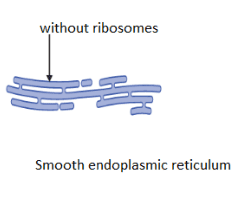
The smooth endoplasmic reticulum helps in the manufacture of
A. Proteins
B. Carbohydrates
C. Lipids
D. Both A and C
Answer
555.9k+ views
Hint:Cell is the basic, smallest, functional unit of life. Cells are composed of various different organelles. The smooth endoplasmic reticulum is one of the cell organelles. The cell organelle which is made up of two subunits called the smooth endoplasmic reticulum (SER) and rough endoplasmic reticulum (RER) together is called the endoplasmic reticulum.
Complete answer: The endoplasmic reticulum (ER) is a type of organelle found in the matrix of cell and is made up of two subunits – rough endoplasmic reticulum (RER), and smooth endoplasmic reticulum (SER). The endoplasmic reticulum attached with a ribosome is called a granular or rough endoplasmic reticulum (RER). It is abundant in cells and is engaged in active secretion and involves the formation of the polypeptide into the lumen of the endoplasmic reticulum. The Rough Endoplasmic Reticulum is the site in the cell where protein synthesis occurs. The absence of ribosomes on the surface of the endoplasmic reticulum is called a smooth endoplasmic reticulum or agranular endoplasmic reticulum (SER). Different types of lipids are secreted by the smooth endoplasmic reticulum. It also involves the synthesis of vitamins and carbohydrates and detoxification. This organelle contains the enzyme involved in lipid synthesis, and as lipids are manufactured in the ER, they are inserted into the organelle’s own membranes. This is because the lipids are too hydrophobic to dissolve into the cytoplasm.

So, option C is the correct option.
Note: Smooth endoplasmic reticulum is found in adipose tissue, muscle cells, glycogen metabolizing liver cells, and steroid hormones. Many general functions performed by the endoplasmic reticulum include the folding of protein molecules in sacks. These sacs are called cisternae.
Complete answer: The endoplasmic reticulum (ER) is a type of organelle found in the matrix of cell and is made up of two subunits – rough endoplasmic reticulum (RER), and smooth endoplasmic reticulum (SER). The endoplasmic reticulum attached with a ribosome is called a granular or rough endoplasmic reticulum (RER). It is abundant in cells and is engaged in active secretion and involves the formation of the polypeptide into the lumen of the endoplasmic reticulum. The Rough Endoplasmic Reticulum is the site in the cell where protein synthesis occurs. The absence of ribosomes on the surface of the endoplasmic reticulum is called a smooth endoplasmic reticulum or agranular endoplasmic reticulum (SER). Different types of lipids are secreted by the smooth endoplasmic reticulum. It also involves the synthesis of vitamins and carbohydrates and detoxification. This organelle contains the enzyme involved in lipid synthesis, and as lipids are manufactured in the ER, they are inserted into the organelle’s own membranes. This is because the lipids are too hydrophobic to dissolve into the cytoplasm.

So, option C is the correct option.
Note: Smooth endoplasmic reticulum is found in adipose tissue, muscle cells, glycogen metabolizing liver cells, and steroid hormones. Many general functions performed by the endoplasmic reticulum include the folding of protein molecules in sacks. These sacs are called cisternae.
Recently Updated Pages
Why are manures considered better than fertilizers class 11 biology CBSE

Find the coordinates of the midpoint of the line segment class 11 maths CBSE

Distinguish between static friction limiting friction class 11 physics CBSE

The Chairman of the constituent Assembly was A Jawaharlal class 11 social science CBSE

The first National Commission on Labour NCL submitted class 11 social science CBSE

Number of all subshell of n + l 7 is A 4 B 5 C 6 D class 11 chemistry CBSE

Trending doubts
Differentiate between an exothermic and an endothermic class 11 chemistry CBSE

10 examples of friction in our daily life

One Metric ton is equal to kg A 10000 B 1000 C 100 class 11 physics CBSE

Difference Between Prokaryotic Cells and Eukaryotic Cells

State the laws of reflection of light

Explain zero factorial class 11 maths CBSE




